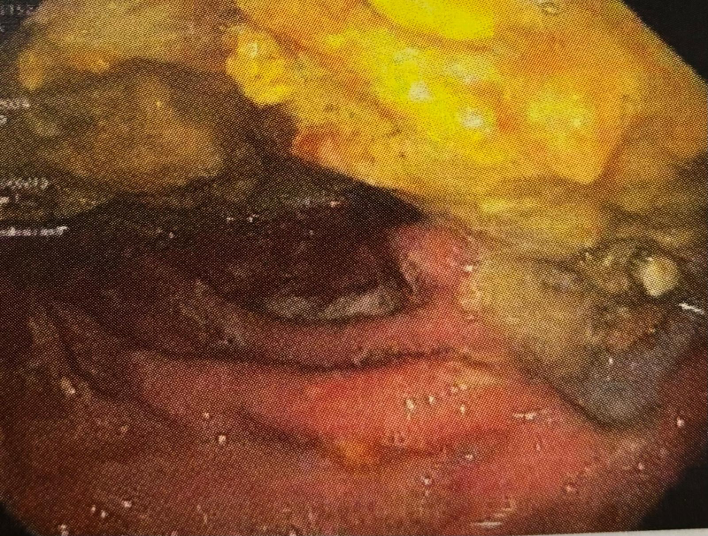Tuesday Poster Session
Category: GI Bleeding
P5253 - Diffuse Large B-Cell Lymphoma: An Uncommon Cause of Upper Gastrointestinal Bleeding - A Case Report
Tuesday, October 28, 2025
10:30 AM - 4:00 PM PDT
Location: Exhibit Hall

Hasan Jaber, MD (he/him/his)
University of Kansas School of Medicine
Wichita, KS
Presenting Author(s)
Hasan Jaber, MD, Fady Eltom, MD, Nader Al Souky, MD, Fawzi Elias, MD, Obada Tayyem, MD
University of Kansas School of Medicine, Wichita, KS
Introduction: Non-Hodgkin Lymphoma (NHL) often affects lymph nodes and extranodal abdominal structures. While gastric involvement may cause upper GI bleeding, massive hemorrhage due to diffuse large B-cell lymphoma (DLBCL) remains exceedingly rare. We present a 62-year-old male with an upper GI bleed caused by gastric DLBCL, underscoring the importance of considering hematologic malignancies in atypical GI hemorrhage.
Case Description/
Methods: A 62-year-old male with no significant past medical history presented with shortness of breath, chest discomfort, and epigastric pain. He reported dark, tarry stools for two months. On arrival, BP was 95/55 mmHg and HR 110 bpm. Hemoglobin was 3.3 g/dL. He was resuscitated with IV fluids and blood transfusions and started on IV pantoprazole. CTA of the abdomen/pelvis showed wall thickening of the stomach along the lesser curvature, extending into the antrum/pylorus, with prominent perigastric lymphadenopathy concerning for malignancy. Esophagogastroduodenoscopy (EGD) revealed a necrotic ulcer on the lesser curvature with suspicion of cancer (Figure 1). H. pylori antigen was negative. Biopsies were positive for CD20 (Figure 2), PAX5 (Figure 3), CD10, and BCL6 which was diagnostic for DLBCL. FISH for double-hit lymphoma was negative. The patient began treatment with rituximab, cyclophosphamide, hydroxydaunomycin, vincristine (Oncovin®), and prednisone (R-CHOP), with good prognosis anticipated. Hemoglobin stabilized at around 8 g/dl and improved after starting therapy.
Discussion: Lymphomas often involve nodal and extranodal abdominal structures, with DLBCL being the most common subtype of NHL. Gastric lymphomas usually present with vague symptoms like abdominal pain, dyspepsia, nausea, vomiting, diarrhea, weight loss, or a palpable mass. GI bleeding is a rare presentation, especially with DLBCL. This patient presented with melena, abdominal pain, and symptoms likely due to anemia. Diagnosis is made via biopsy, as imaging lacks specificity. For gastric lesions, biopsies are typically obtained by EGD. Initial treatment for upper GI bleed includes IV pantoprazole. If a visible vessel is present, clip placement and argon plasma coagulation may be used. Current management of DLBCL favors immunochemotherapy, with R-CHOP being the standard first-line regimen. Surgery is now reserved for managing complications such as perforation, uncontrolled bleeding, or obstruction.

Figure: Necrotic ulcer on the lesser curvutaure of the stomach found on EGD.

Figure: Immunohistochemistry Highlighting CD20-Positive B-Cells Consistent with Diffuse Large B-Cell Lymphoma
Disclosures:
Hasan Jaber indicated no relevant financial relationships.
Fady Eltom indicated no relevant financial relationships.
Nader Al Souky indicated no relevant financial relationships.
Fawzi Elias indicated no relevant financial relationships.
Obada Tayyem indicated no relevant financial relationships.
Hasan Jaber, MD, Fady Eltom, MD, Nader Al Souky, MD, Fawzi Elias, MD, Obada Tayyem, MD. P5253 - Diffuse Large B-Cell Lymphoma: An Uncommon Cause of Upper Gastrointestinal Bleeding - A Case Report, ACG 2025 Annual Scientific Meeting Abstracts. Phoenix, AZ: American College of Gastroenterology.
University of Kansas School of Medicine, Wichita, KS
Introduction: Non-Hodgkin Lymphoma (NHL) often affects lymph nodes and extranodal abdominal structures. While gastric involvement may cause upper GI bleeding, massive hemorrhage due to diffuse large B-cell lymphoma (DLBCL) remains exceedingly rare. We present a 62-year-old male with an upper GI bleed caused by gastric DLBCL, underscoring the importance of considering hematologic malignancies in atypical GI hemorrhage.
Case Description/
Methods: A 62-year-old male with no significant past medical history presented with shortness of breath, chest discomfort, and epigastric pain. He reported dark, tarry stools for two months. On arrival, BP was 95/55 mmHg and HR 110 bpm. Hemoglobin was 3.3 g/dL. He was resuscitated with IV fluids and blood transfusions and started on IV pantoprazole. CTA of the abdomen/pelvis showed wall thickening of the stomach along the lesser curvature, extending into the antrum/pylorus, with prominent perigastric lymphadenopathy concerning for malignancy. Esophagogastroduodenoscopy (EGD) revealed a necrotic ulcer on the lesser curvature with suspicion of cancer (Figure 1). H. pylori antigen was negative. Biopsies were positive for CD20 (Figure 2), PAX5 (Figure 3), CD10, and BCL6 which was diagnostic for DLBCL. FISH for double-hit lymphoma was negative. The patient began treatment with rituximab, cyclophosphamide, hydroxydaunomycin, vincristine (Oncovin®), and prednisone (R-CHOP), with good prognosis anticipated. Hemoglobin stabilized at around 8 g/dl and improved after starting therapy.
Discussion: Lymphomas often involve nodal and extranodal abdominal structures, with DLBCL being the most common subtype of NHL. Gastric lymphomas usually present with vague symptoms like abdominal pain, dyspepsia, nausea, vomiting, diarrhea, weight loss, or a palpable mass. GI bleeding is a rare presentation, especially with DLBCL. This patient presented with melena, abdominal pain, and symptoms likely due to anemia. Diagnosis is made via biopsy, as imaging lacks specificity. For gastric lesions, biopsies are typically obtained by EGD. Initial treatment for upper GI bleed includes IV pantoprazole. If a visible vessel is present, clip placement and argon plasma coagulation may be used. Current management of DLBCL favors immunochemotherapy, with R-CHOP being the standard first-line regimen. Surgery is now reserved for managing complications such as perforation, uncontrolled bleeding, or obstruction.

Figure: Necrotic ulcer on the lesser curvutaure of the stomach found on EGD.

Figure: Immunohistochemistry Highlighting CD20-Positive B-Cells Consistent with Diffuse Large B-Cell Lymphoma
Disclosures:
Hasan Jaber indicated no relevant financial relationships.
Fady Eltom indicated no relevant financial relationships.
Nader Al Souky indicated no relevant financial relationships.
Fawzi Elias indicated no relevant financial relationships.
Obada Tayyem indicated no relevant financial relationships.
Hasan Jaber, MD, Fady Eltom, MD, Nader Al Souky, MD, Fawzi Elias, MD, Obada Tayyem, MD. P5253 - Diffuse Large B-Cell Lymphoma: An Uncommon Cause of Upper Gastrointestinal Bleeding - A Case Report, ACG 2025 Annual Scientific Meeting Abstracts. Phoenix, AZ: American College of Gastroenterology.
